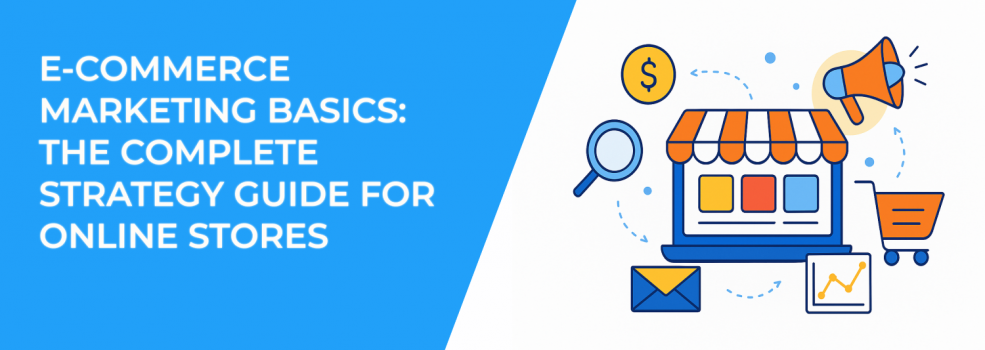E-commerce marketing is about more than just getting people to your site. It’s about attracting the right visitors, guiding them to buy, and encouraging them to return.
If you run an online store, marketing isn't a one-time effort — it's ongoing. You’ll need to balance strategy with execution and short-term wins with long-term growth. This guide breaks it all down in a clear, practical way.
1. Get Your Foundation in Place Before You Promote Anything
Before spending on ads or chasing trends, make sure your store is set up for success. Many online stores skip this part and waste money sending traffic to pages that don’t convert.
Ask yourself:
-
Do your product pages clearly show value?
-
Can visitors quickly understand what makes your brand different?
-
Is it easy to navigate your site on mobile?
A strong foundation will make every marketing channel work better. This includes your branding, product positioning, and customer experience.
Key tasks to focus on:
-
Clarify your unique value. Explain what sets your product apart in one short sentence. Avoid vague claims — be specific and results-focused.
-
Simplify navigation. Make it easy to find products. Use clear categories, a visible search bar, and a smart homepage layout.
-
Improve product pages. Use real customer reviews, clear pricing, quality photos, and simple, benefit-focused descriptions.
These are the elements that directly affect conversion rates. Without them, even great marketing won’t deliver long-term results.
2. SEO: Your Store’s Best Long-Term Growth Channel
Search engine optimization can drive consistent traffic to your site — without relying on ad spend.
Start with basic keyword research. Look for terms people are actually searching for, especially ones with buying intent.
Here’s how to build SEO into your site:
-
Use keywords naturally. Add them to product titles, meta descriptions, headers, and URLs. Don’t overdo it — keep the language clear.
-
Create helpful blog content. Focus on topics that relate directly to your products. For example, if you sell hiking gear, write posts like “Top 5 Day Hikes for Beginners” or “How to Choose the Right Hiking Backpack.”
-
Optimize for mobile. Google considers mobile performance when ranking your pages. A fast, responsive design is essential.
It takes time to see results from SEO, but the payoff is worth it. Once a post ranks, it can bring in free traffic for months — or even years.
3. Paid Ads: Start Small, Learn Fast
Paid advertising can help you scale, but only when used carefully. Don’t launch broad campaigns without testing first.
Here’s how to use paid ads effectively:
-
Begin with retargeting. Start by showing ads to people who’ve already visited your site. These users are more likely to convert.
-
Use product-specific creatives. Avoid generic brand messaging. Show the exact item someone viewed, along with a clear benefit or offer.
-
Test frequently. Try different headlines, visuals, and formats. Track what works. Drop what doesn’t.
A $10 daily test can teach you more than a week of guesswork. Focus on data — not gut feeling.
Here's a simple paid ads strategy you can use:
| Step | What to Focus On | Why It Matters |
| Campaign Objective | Match with purchase intent | Better alignment = higher conversions |
| Audience Targeting | Start with retargeting | Warmer traffic is easier to convert |
| Creative Testing | Run small tests with visuals and copy | Identify what resonates fast |
For more help with your structure, check out Meta Ad Campaign Objectives Explained.
4. Use Email Marketing to Keep Customers Engaged
Email marketing remains one of the most profitable e-commerce channels. It helps you stay in touch without relying on algorithms or ad platforms.
Focus on setting up a few core automations first:
-
Welcome email series. Introduce your brand and bestsellers. Use 2–3 emails spread over a few days.
-
Abandoned cart reminders. Send one email 1 hour after cart abandonment, and another within 24 hours. Offer help or a small incentive.
-
Post-purchase flow. Thank your customer. Share helpful tips or suggest related products. Ask for a review after delivery.
You can always expand your campaigns later, but starting with these three gives you the most return for your time.
Want to double down? Learn how to combine both channels in How to Boost Email Marketing With Facebook Ads.
5. Content and Social Media Marketing: Be Useful, Not Just Visible
Many brands post often but say very little. Instead of flooding your feed, focus on value.
Think about what your audience needs or wonders about — then create content that answers those questions.
A simple, effective approach:
-
Educate. Show how to use your product, compare options, or solve a related problem. Keep it simple and visual.
-
Show behind the scenes. Transparency builds trust. Show how products are made or how your team works.
-
Encourage interaction. Ask for opinions. Run polls or quizzes. Respond to comments — it’s about connection, not just reach.
Social platforms are noisy. Value-driven content helps you cut through and build a real following.
6. Influencer and Affiliate Partnerships: Scale Word of Mouth
Real people recommending your product is one of the strongest forms of marketing.
But influencer campaigns only work when there's alignment between the creator and your product.
Here’s how to approach it:
-
Choose the right partners. Look for creators whose followers match your target audience. Engagement rate matters more than follower count.
-
Set clear expectations. Outline what type of content you want, when it’s due, and how you’ll measure success.
-
Track performance. Use affiliate links or promo codes to track sales. Monitor reach and engagement as well, but focus on ROI.
Even one strong partnership can drive a surge in both traffic and trust — especially if the influencer continues using your product after the campaign ends.
7. Measure What Matters — And Ignore the Rest
It’s easy to get overwhelmed by metrics. Focus on a few that reflect real business outcomes.
Start with these:
| Metric | What It Measures | Why It’s Useful |
| Conversion Rate (CVR) | Visitor to buyer ratio | Reveals how well your site converts |
| Customer Acquisition Cost (CAC) | Cost to acquire each customer | Helps budget and assess ad efficiency |
| Customer Lifetime Value (CLV) | Average revenue per customer | Shows long-term profitability |
| Return on Ad Spend (ROAS) | Revenue per dollar of ad spend | Measures paid marketing performance |
Use tools like Google Analytics, Shopify reports, and Meta Ads Manager. Just make sure you're asking the right questions when reviewing it.
Summary: The Best Strategy Is the One You Can Stick With
You don’t need to master every channel overnight. Focus on building one system at a time: get your store conversion-ready, then bring in targeted traffic, then build relationships through email and content.
As your store grows, you’ll learn which strategies deliver the best ROI and which ones are just nois

